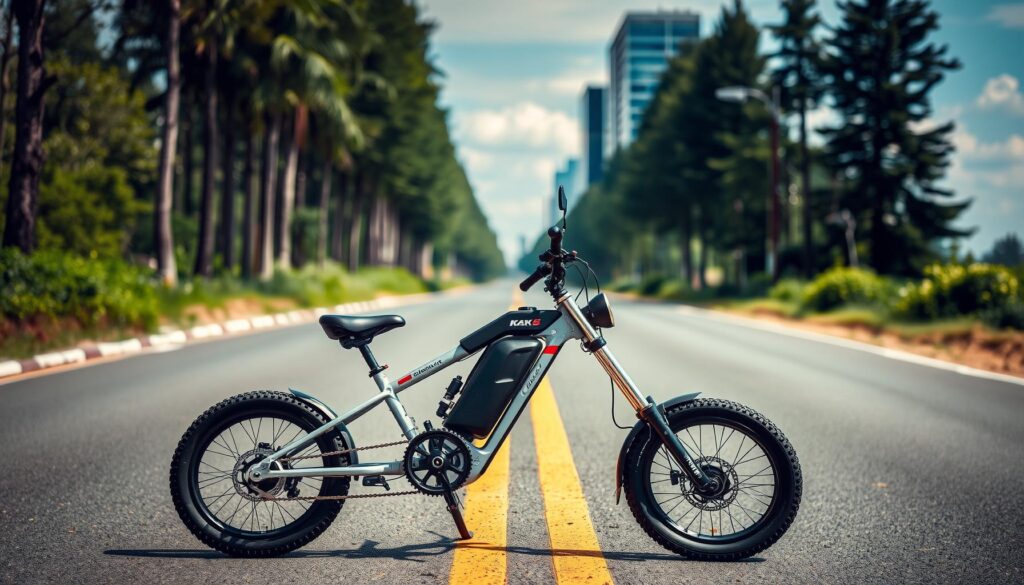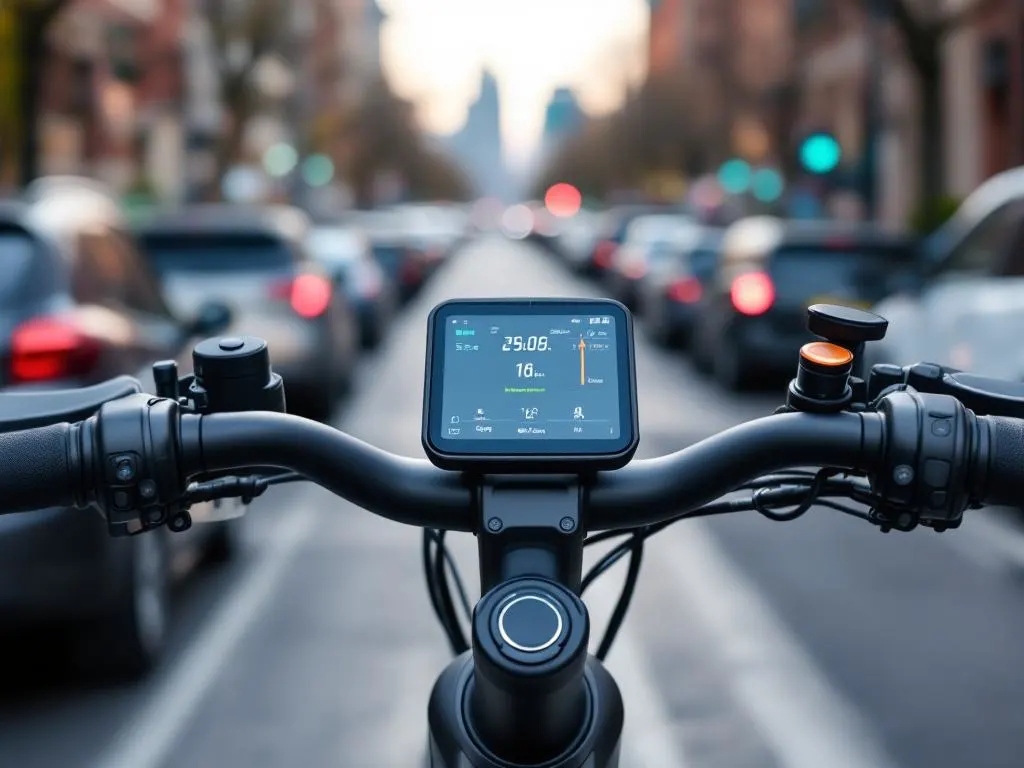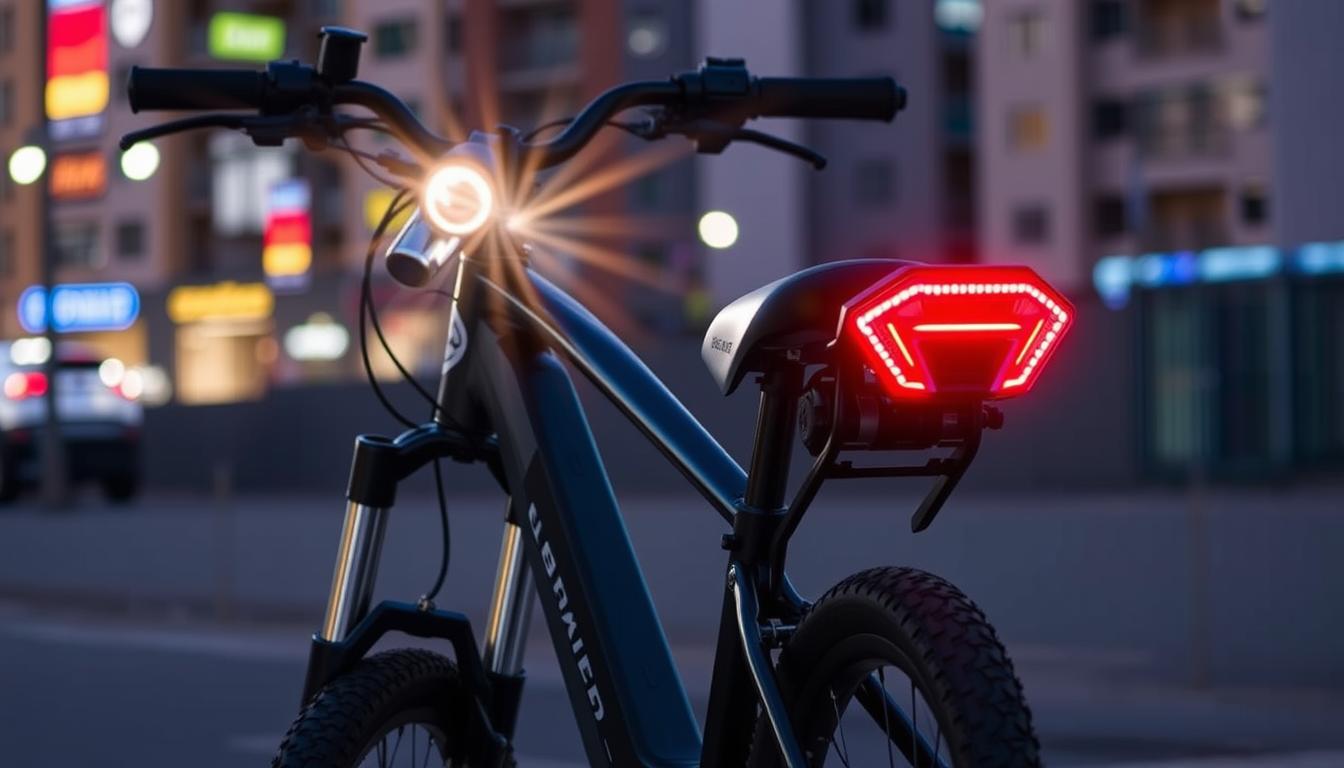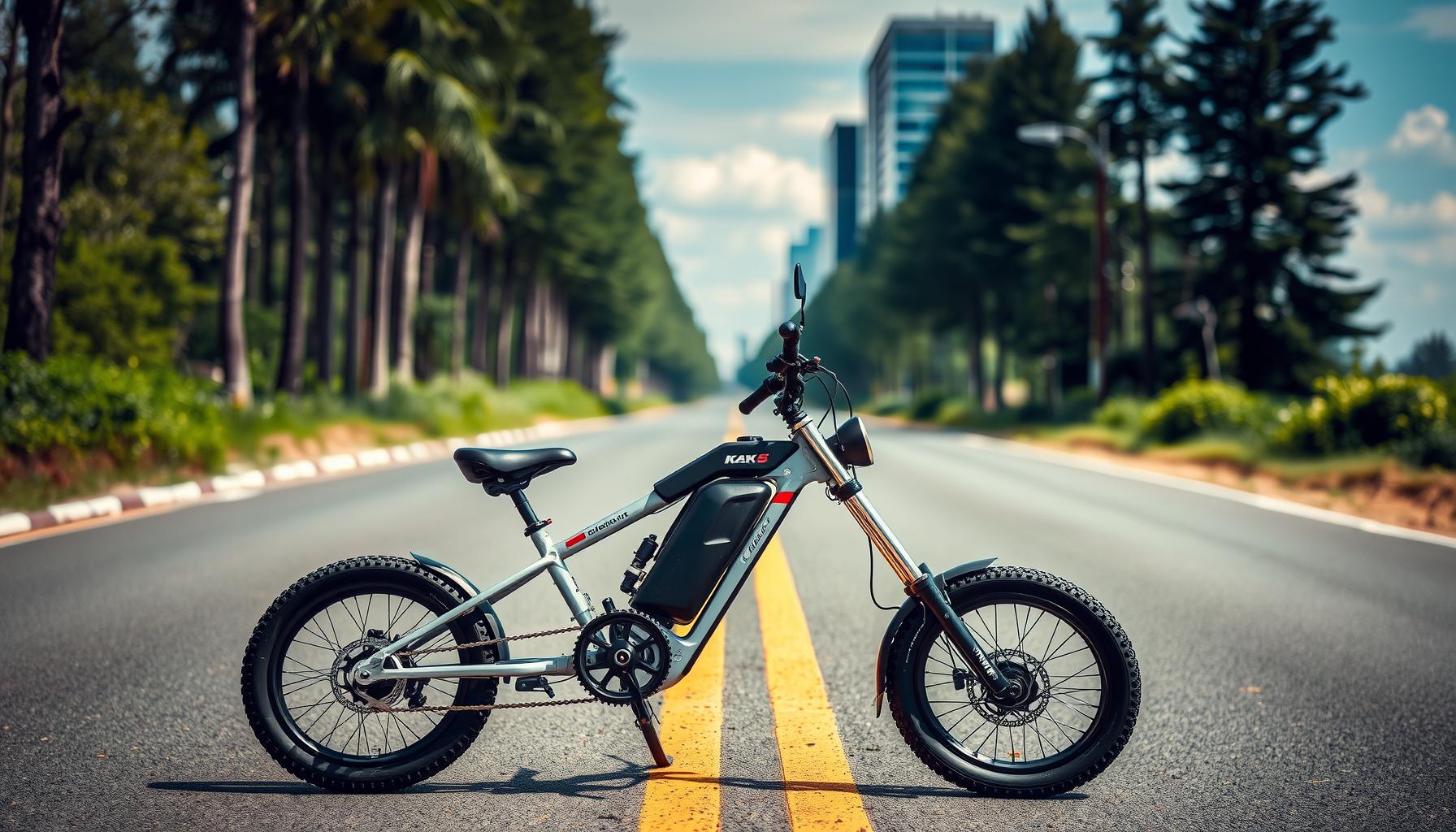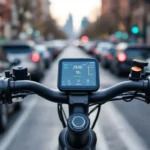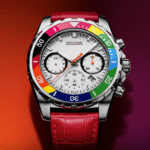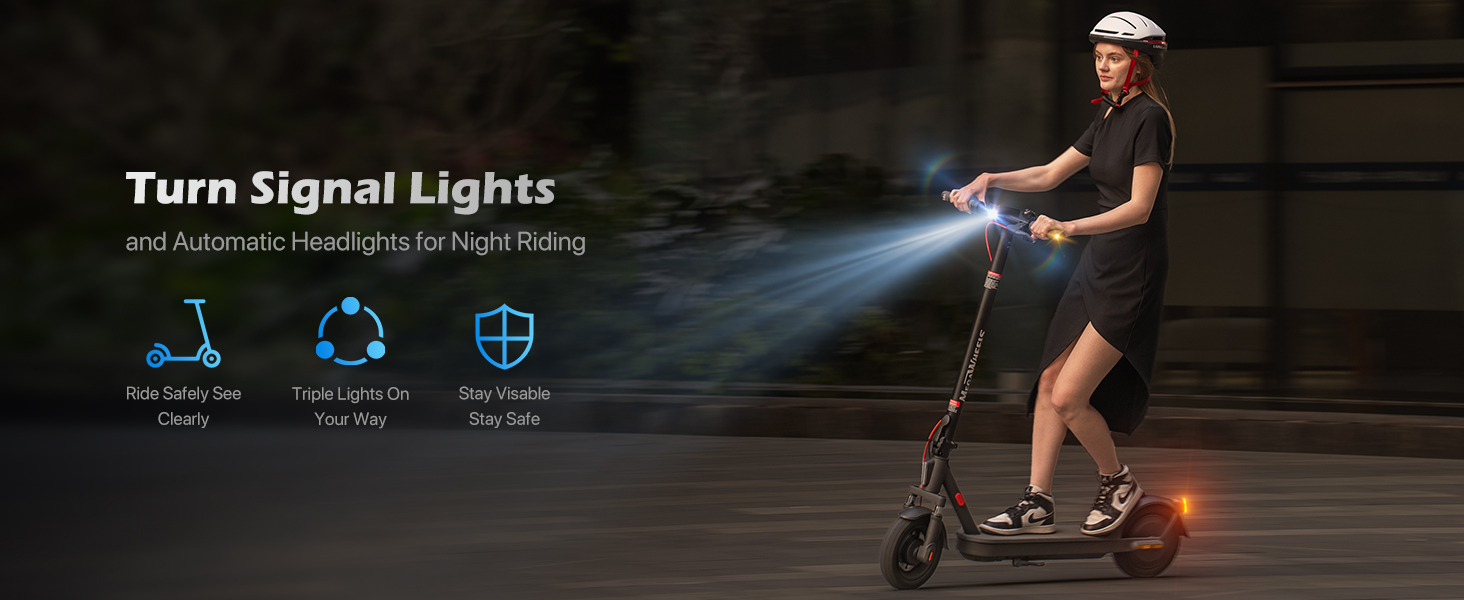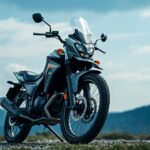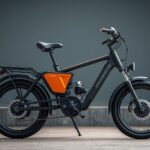Now Reading: E-bike Reviews & Comparisons: Find Your Perfect Ride
-
01
E-bike Reviews & Comparisons: Find Your Perfect Ride
E-bike Reviews & Comparisons: Find Your Perfect Ride
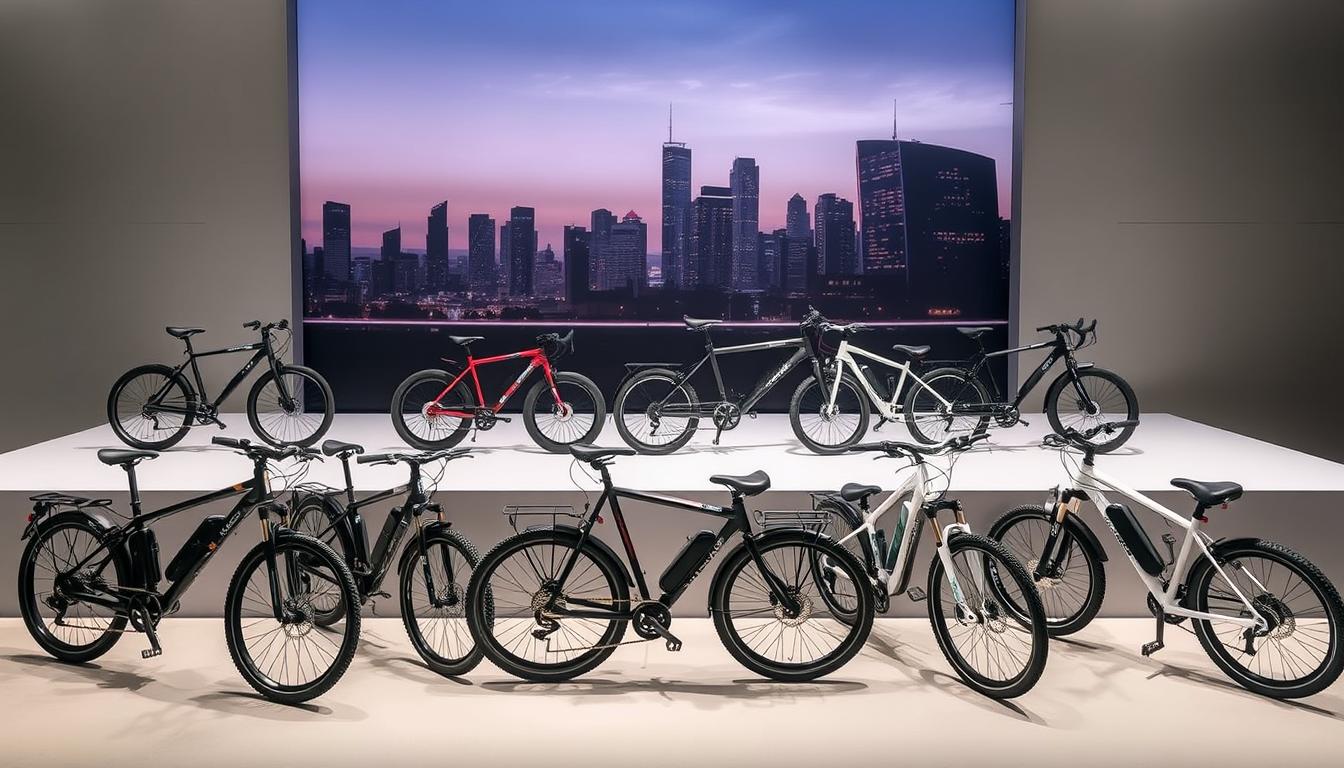
Table of Contents
Imagine riding through the city or tackling mountain trails with ease. E-bike reviews & comparisons are your key to finding the perfect ride. They change how you see transportation and adventure.
Electric bicycles are changing how we move, blending tech, green living, and fun. Whether you need a quick way to get to work or a thrilling ride outdoors, the best electric bikes of 2023 are here for you.
Our guide will help you through the exciting world of e-bikes. We’ll show you how to choose the right bike for your life, budget, and how you like to ride. From tech specs to top models, we’re here to help you find your perfect ride.
Key Takeaways
- Explore diverse e-bike categories for various riding styles
- Understand essential technologies and performance features
- Learn how to match an e-bike to your specific needs
- Discover budget-friendly and premium electric bicycle options
- Get expert insights on making the right purchase
Understanding E-bike Basics: Types and Technologies
Electric bicycles have changed how we travel, mixing human effort with electric help. Knowing the basics is key when looking at e-bike reviews & comparisons.
There are many types of electric bikes, each for different needs and rules. Let’s look at what makes these bikes so useful.
E-bike Classifications Demystified
E-bikes are mainly split into three groups:
- Class 1: Bikes that help with pedaling up to 20 mph
- Class 2: Bikes with a throttle, going up to 20 mph
- Class 3: Faster bikes that help with pedaling up to 28 mph
Essential Components of Electric Bicycles
To understand commuter e-bike features, you need to know the main parts:
- Electric Motor: The core, adding power
- Battery: Affects range and performance
- Controller: Controls power and assistance
- Display: Shows speed, battery, and mode
Power Assistance Levels Explained
E-bikes have different power levels. You can pick from eco to turbo mode. This choice affects battery life and how far you can go.
Pro tip: Pick a level that matches your effort and battery use.
Knowing these basics helps you better understand e-bike reviews & comparisons. This way, you can find the right electric bike for you.
Top E-bike Brands and Models for 2023
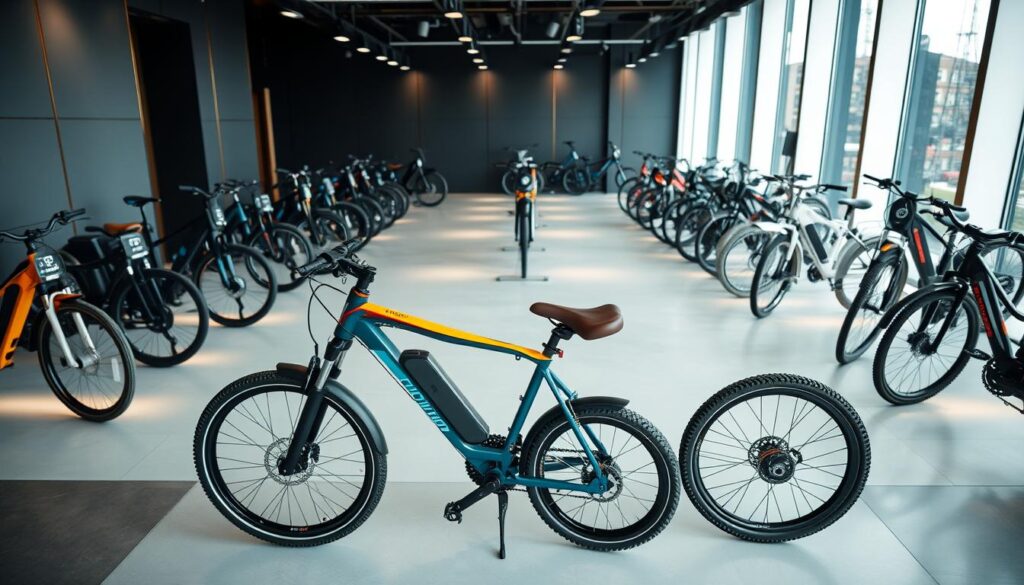
Finding the best electric bicycles for 2023 can be tough. This guide will show you the top brands and models. They’re changing how we move around cities and enjoy the outdoors.
Many top brands are leading the e-bike market. They offer new designs and the latest tech. Your ideal e-bike depends on what you need it for, like commuting or off-road adventures.
- Rad Power Bikes: Known for affordable, versatile electric bicycles
- Trek: Premium performance with advanced technological integration
- Specialized: High-end models with exceptional build quality
- Giant: Reliable electric bicycles with excellent range
When looking at e-bike reviews & comparisons, keep these points in mind:
- Battery range and charging efficiency
- Motor power and assistance levels
- Frame design and weight
- Price point and value proposition
| Brand | Top Model 2023 | Price Range | Best For |
|---|---|---|---|
| Rad Power Bikes | RadRover 6 Plus | $1,999 | All-terrain commuting |
| Trek | Verve+ 3 | $2,499 | Urban riding |
| Specialized | Turbo Vado 4.0 | $3,750 | Performance enthusiasts |
Pro tip: Always test ride multiple models to find your perfect electric bicycle match.
Affordable E-bikes Under $1,500: Budget-Friendly Options
Finding an affordable e-bike doesn’t mean you have to sacrifice quality. Even on a tight budget, you can enjoy the benefits of electric bicycles. Many affordable e-bikes offer great value for those new to electric cycling.
When looking for affordable e-bikes, it’s important to know what to look for. Budget-friendly models usually have the basics that make electric cycling fun for everyone.
Entry-Level Features to Look For
- Battery range of 20-40 miles
- Pedal-assist modes with multiple levels
- Lightweight frame materials
- Basic suspension systems
- Comfortable seat design
Best Value Electric Bikes
There are quality e-bikes under $1,500 that perform well. Brands like Lectric, Aventon, and RadPower have great options for those on a budget. They offer reliable electric bicycles.
Cost-Saving Tips When Buying
- Consider previous year’s models for discounts
- Look for seasonal sales events
- Check manufacturer refurbished options
- Compare warranty coverage
- Research local dealer incentives
Your perfect affordable e-bike is out there. By knowing what to look for and being smart about your purchase, you can find a great electric bicycle. You won’t have to spend a lot of money.
Premium Electric Bikes: High-End Performance Reviews
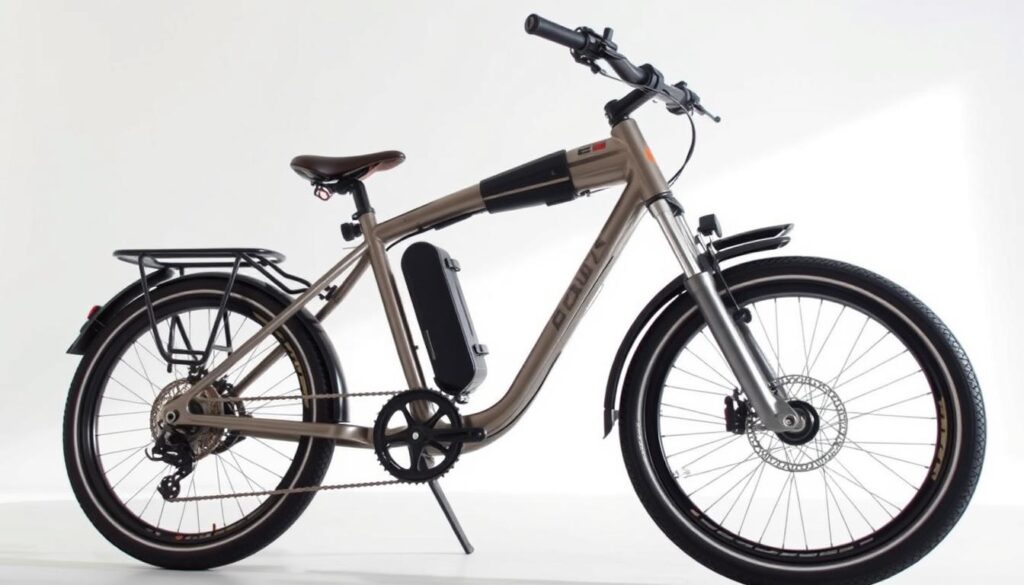
Premium electric bikes are the top of the line in e-bike technology. They offer a unique cycling experience that’s more than just getting from point A to point B.
The best electric bikes of 2023 are a testament to top-notch engineering and design. These bikes are made with the latest tech to perform well on different terrains and conditions.
- Advanced motor systems with superior power output
- Lightweight carbon fiber frames
- Intelligent battery management technologies
- Precision electronic control interfaces
Premium e-bikes stand out with their top-notch parts and careful craftsmanship. They come with big batteries for longer rides, strong motors for more power, and smooth suspension for a better ride.
| Premium E-Bike Model | Motor Power | Battery Range | Price Range |
|---|---|---|---|
| Specialized Turbo Vado SL | 240W | 80 miles | $4,800 |
| Trek Domane+ SLR 7 | 250W | 70 miles | $6,999 |
| Riese & Müller Supercharger2 | 500W | 100 miles | $7,500 |
Buying a premium electric bike means getting an amazing ride. It’s a mix of the latest tech and top performance.
Mountain E-bikes: Trail Performance and Capability
Mountain e-bikes have changed off-road cycling, bringing new excitement to trails. They mix advanced tech with tough designs to conquer tough terrains. This makes your mountain biking adventures better.
Several key factors affect your mountain e-bike ride. The right e-bike can turn tough trails into fun rides. It gives you power and control that regular bikes can’t.
Suspension Systems and Handling
Your e-bike’s suspension is key for a smooth ride. Modern e-bikes have top-notch suspension. It makes riding more comfortable and in control:
- Full-suspension designs soak up trail bumps
- Adjustable dampening for various terrains
- Integrated shock systems
Off-Road Battery Performance
Battery life is vital for mountain e-bike rides. Look at these important points when picking your bike:
- Battery size (30-75 miles)
- Power for steep hills
- Works well in cold or hot weather
Terrain-Specific Features
E-bike reviews & comparisons show special features for mountain e-bikes. Look for:
- Wide, knobby tires for better grip
- Strong frame materials
- Sturdy drivetrain parts
Choosing the right mountain e-bike means knowing your trail needs. Then, find a bike with the right tech.
Commuter E-bikes: Urban Mobility Solutions
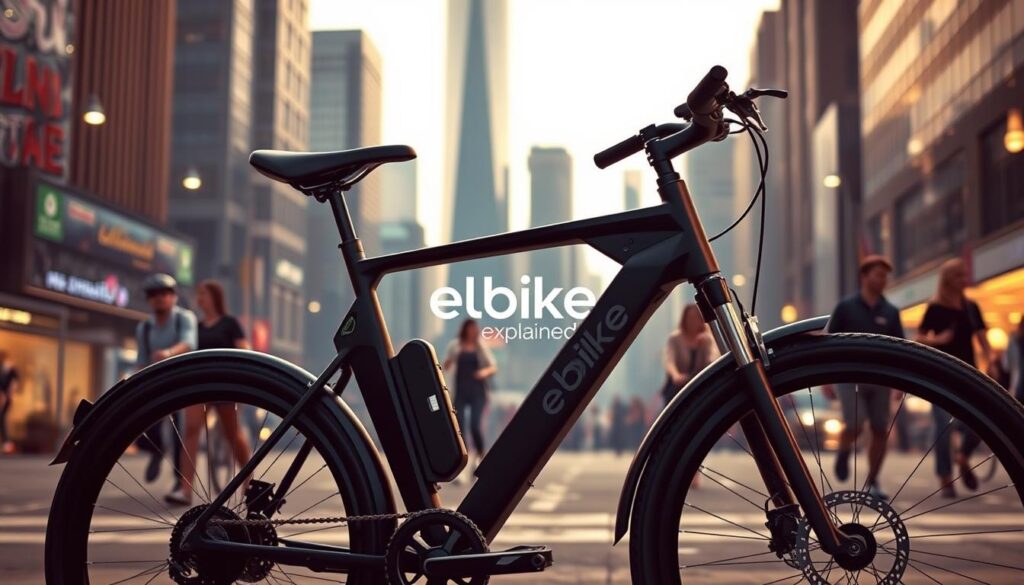
Urban commuters are finding electric bicycles to be a game-changer. These bikes offer a smart way to travel in the city. They make your daily commute faster, smoother, and more fun.
When looking at e-bike reviews & comparisons, urban riders should focus on a few key things. These include:
- Integrated safety features
- Compact and lightweight design
- Practical storage options
- Extended battery range
- Smart connectivity
Modern commuter e-bikes have cool tech that makes city travel better. Theft prevention systems, GPS, and app controls are now common. They help riders get to their destinations safely and easily.
“The future of urban transportation is electric, compact, and intelligent.” – Urban Mobility Expert
Here’s a quick look at what makes top commuter e-bikes great:
| Feature | Essential Benefit | Typical Range |
|---|---|---|
| Battery Range | Daily Commute Coverage | 25-50 miles |
| Charging Time | Convenience | 3-6 hours |
| Weight | Portability | 40-55 lbs |
| Smart Features | Connectivity | Mobile App Integration |
Your perfect commuter e-bike depends on your city life. Think about how far you travel, the terrain, and what you like. This will help you find the best urban mobility solution for you.
E-bike Reviews & Comparisons: Expert Analysis
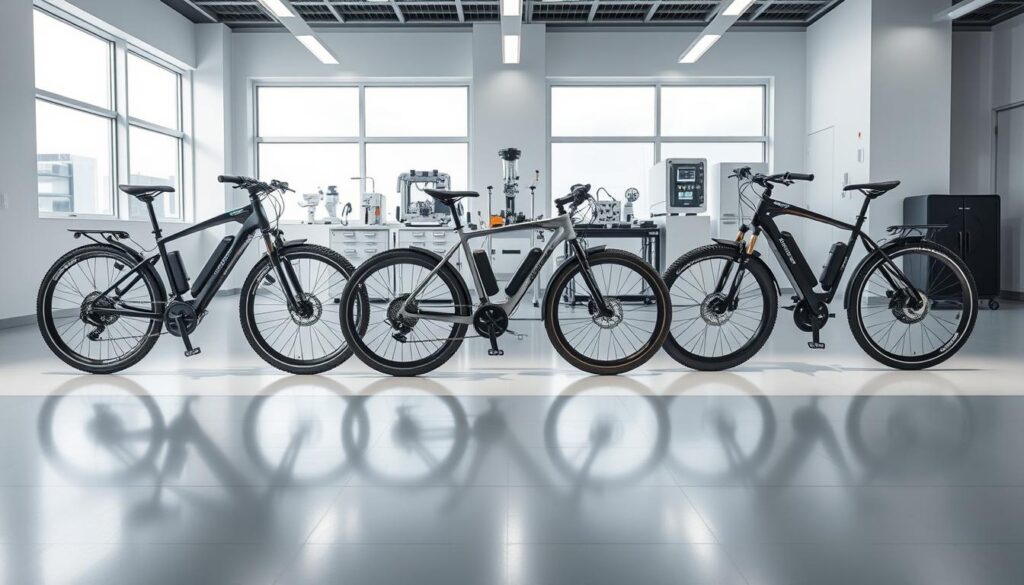
Finding the right e-bike can be tough. Our expert analysis covers the key points of electric bike performance. This helps you choose wisely.
Performance Metrics Explained
Experts look at several important factors in e-bike reviews. These help understand how well an e-bike performs:
- Range: How far you can go on one charge
- Top Speed: The fastest speed with motor help
- Acceleration: How fast it gets to top speed
- Hill-Climbing Ability: How it handles tough hills
Real-World Testing Results
Our tests show big differences in e-bike battery life. We test bikes in real-life situations to give you true performance info.
| Model | Range (Miles) | Top Speed (MPH) | Battery Efficiency |
|---|---|---|---|
| Urban Commuter X | 45 | 20 | High |
| Trail Master Pro | 35 | 25 | Medium |
User Experience Feedback
What riders think is just as important as the bike’s specs. Long-term users share their thoughts on comfort, reliability, and overall joy of riding.
“The real test of an e-bike isn’t just its specs, but how it performs in daily life.” – Professional E-bike Tester
By looking at expert opinions, performance data, and user feedback, you can pick the perfect e-bike. It will meet your needs and exceed your expectations.
Battery Life and Charging Technology
When looking at e-bike reviews & comparisons, battery performance is key. Knowing about battery life is essential for a good electric cycling experience. Today’s e-bikes have advanced battery tech that greatly affects range and performance.
Different battery types change your ride. Lithium-ion batteries are the most common. They offer great power and last a long time. When comparing e-bike batteries, look at several important factors:
- Battery capacity (measured in watt-hours)
- Charging time and efficiency
- Voltage and power output
- Environmental resistance
Things that affect battery performance include:
- Rider weight
- Terrain complexity
- Pedal assist level
- Weather conditions
Top brands now have removable battery systems. These make charging easier and more flexible. Some e-bikes can charge quickly, even in just 90 minutes. When reviewing e-bikes, check the battery specs to see if they fit your needs.
Pro tip: Always store your e-bike battery at room temperature and avoid complete discharge to maximize its lifespan.
Learning about battery tech helps you choose an e-bike that works well. It ensures you get the performance you need for your daily rides.
Motor Systems: Hub vs Mid-Drive Comparison
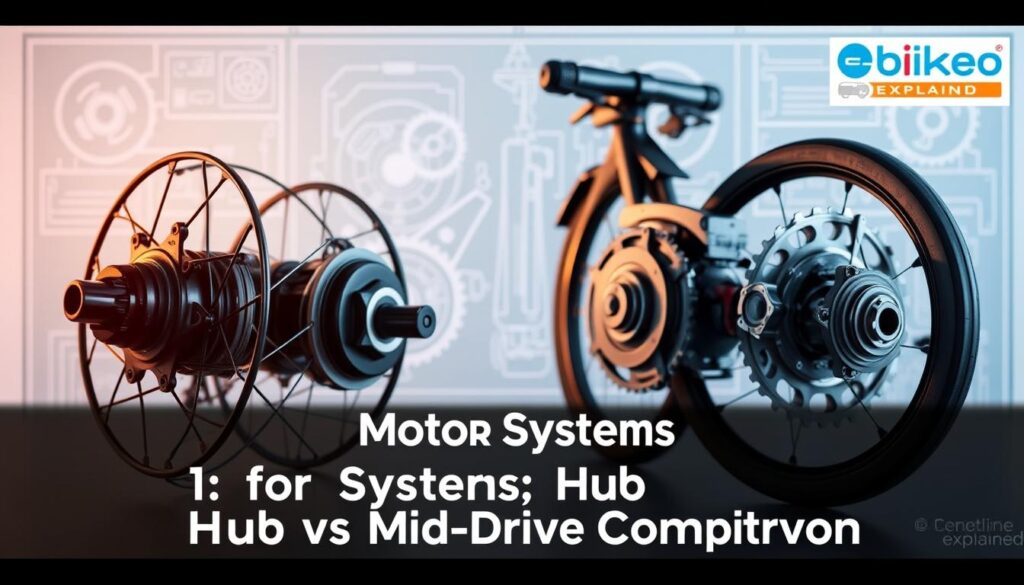
Choosing an electric bicycle means understanding the difference between hub and mid-drive motors. Each type has its own benefits that can change how you ride.
E-bike motor efficiency changes a lot between hub and mid-drive motors. Let’s look at what makes them different.
Torque and Power Output
Mid-drive motors give more torque and power than hub motors. They sit at the bike’s center. This gives:
- Better weight distribution
- Improved climbing
- A more natural ride
Efficiency and Range
Efficiency is key when comparing mid-drive and hub motors. Mid-drive motors work with your bike’s gears. This means:
- Less energy used
- Longer battery life
- Better performance on different terrains
| Motor Type | Efficiency | Power Output | Terrain Performance |
|---|---|---|---|
| Hub Motor | Moderate | Lower | Flat surfaces |
| Mid-Drive Motor | High | Higher | Varied terrain |
Maintenance Considerations
Choosing between mid-drive and hub motors affects maintenance. Mid-drive motors need special care, while hub motors are easier to maintain.
Think about your riding style, the terrain, and how much you want to maintain your bike. Each motor type has its own advantages that can make your ride better.
Folding E-bikes: Portable Transportation Options
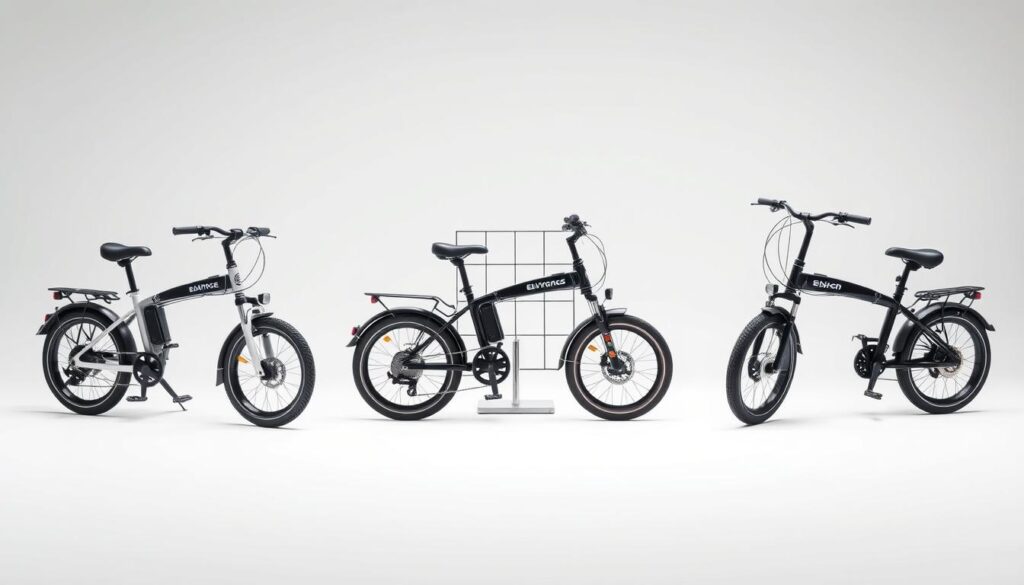
Urban commuters and travelers are finding the amazing benefits of folding electric bikes. These bikes are perfect for those with little storage or complex commutes.
Folding e-bikes are known for their unique design and ease of carrying. They usually weigh 35-55 pounds. This makes them great for small spaces like apartments or offices.
- Compact design allows easy storage in small spaces
- Lightweight frames for simple lifting and carrying
- Compatible with multiple transportation methods
- Ideal for multi-modal commuting
When looking at folding electric bikes, consider a few important features:
- Folding mechanism speed
- Battery integration
- Weight distribution
- Wheel size
Brands like Brompton, Tern, and RadPower have made folding bikes that are both easy to use and perform well. These bikes can go 20-50 miles on one charge, which is great for city trips.
Your perfect urban transportation might be just a fold away!
When picking a folding e-bike, think about what you need. Consider your commute, storage space, and what you want from your bike.
Cargo E-bikes: Hauling Capacity and Utility
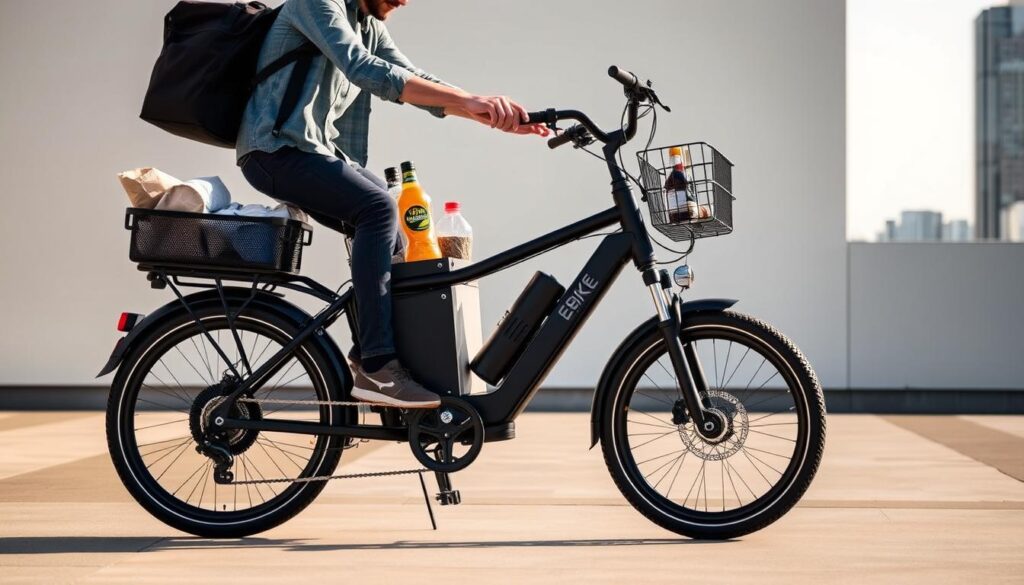
Cargo electric bikes have changed how we move around cities. They are great for families, small businesses, and anyone who needs a reliable way to carry things. They’re also good for the planet.
There are many types of cargo e-bikes, each designed for different needs. Knowing what they can do helps you pick the best one for you.
Weight Limits and Distribution
When picking a cargo e-bike, think about how much it can carry and how to spread the weight. Each model has its own strengths:
- Longtail designs: Typically support 300-400 pounds
- Mid-tail bikes: Ideal for lighter loads around 200-250 pounds
- Front-loader models: Excellent for bulky items with centralized weight
Storage Solutions and Accessories
Cargo e-bikes are customizable. Reviews show many ways to add storage:
- Integrated rear racks
- Removable cargo boxes
- Modular pannier systems
- Child seat attachments
Family-Friendly Features
For families, look for these features in cargo electric bikes:
- Stable frame design
- Adjustable seat heights
- Safety harness compatibility
- Smooth pedal-assist modes
| Cargo E-bike Type | Max Weight Capacity | Best Use |
|---|---|---|
| Longtail | 400 lbs | Family transport, grocery runs |
| Mid-tail | 250 lbs | Urban commuting, light cargo |
| Front-loader | 350 lbs | Business deliveries, bulky items |
Getting a cargo electric bike changes how you travel. It’s a smart choice for easy movement and being kind to the environment.
Safety Features and Regulations
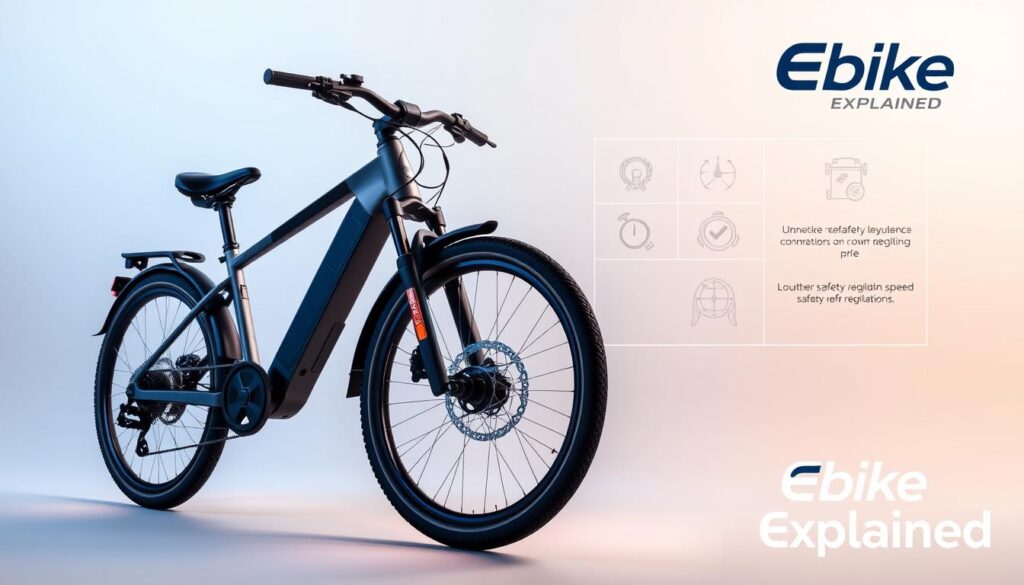
When looking at e-bike reviews & comparisons, safety is key. Modern electric bikes have advanced safety tech. This tech helps keep riders safe in cities and countryside.
Knowing the important safety features helps you choose the right e-bike. Key safety elements include:
- Integrated LED lighting systems
- Reflective frame components
- Hydraulic disc brakes
- Anti-lock braking systems (ABS)
- Traction control mechanisms
E-bike laws differ by area, so knowing local rules is vital. In the United States, there are specific rules for e-bike riders:
| Regulation Category | Typical Requirements |
|---|---|
| Maximum Speed | 20-28 mph depending on classification |
| Power Restrictions | 750 watts maximum motor output |
| Riding Locations | Bike lanes, multi-use paths, designated road shoulders |
Safety isn’t just about the bike. Proper maintenance and responsible riding are also key. Always wear a helmet, follow traffic rules, and stay visible to others.
“Safety is not an accident—it’s a choice.” – E-bike Safety Expert
When looking at e-bike reviews & comparisons, choose models with lots of safety features. Your safety should never be traded for convenience or cost.
Making Your Final Decision: Buying Guide
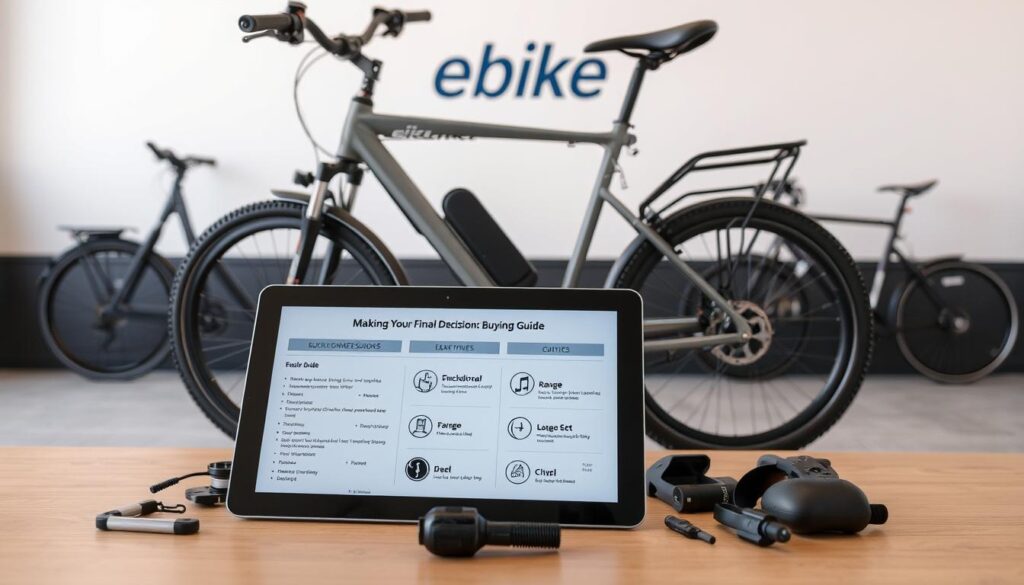
Choosing the right e-bike needs careful thought and research. E-bike reviews & comparisons guide you through the electric bike world. They help you find a bike that fits your needs and budget.
Finding affordable e-bikes means knowing what to look for. These factors will help you choose a bike you’ll love.
Test Ride Tips for Confident Selection
When trying out e-bikes, keep these tips in mind:
- Check comfort and ergonomic fit
- Test different power assistance levels
- Evaluate handling on various terrains
- Assess battery range during ride
Warranty Considerations
Warranty details are key to protecting your investment:
| Warranty Component | Typical Coverage | Recommended Action |
|---|---|---|
| Frame | 2-5 years | Verify material and manufacturing defects |
| Battery | 1-2 years | Check capacity retention guarantees |
| Motor | 1-3 years | Understand replacement conditions |
Price-Performance Analysis
When looking at affordable e-bikes, consider more than the price. Think about long-term value, like maintenance costs and battery efficiency. Also, think about how you’ll use the bike.
- Compare component quality
- Assess range and power
- Calculate total ownership cost
- Consider intended usage
Remember, the best e-bike is one that meets your specific transportation needs while providing reliable performance and enjoyment.
Conclusion
Finding the right e-bike can seem tough, but you now know what to look for. The top electric bikes of 2023 have something for everyone. Whether you’re commuting, hitting trails, or just enjoying a ride, your perfect bike is out there.
Choosing an electric bike means looking at many details. Things like motor type, battery life, and how you’ll use it are key. With new tech coming out fast, there’s always something new to try.
When picking an e-bike, don’t forget to do your homework and test them out. There’s a bike for every rider, no matter your budget or lifestyle. Getting an e-bike is more than just a way to get around. It’s a step towards a greener, more innovative future.
The future of getting around is electric, and e-bikes are at the forefront. Keep up with the latest tech and think about how you’ll use your bike. This way, you’ll find the perfect e-bike for you and enjoy every ride.
FAQ
What are the main types of e-bikes available?
How do e-bike classifications work?
What should I consider when buying an affordable e-bike?
What are the main types of e-bikes available?
How do e-bike classifications work?
What should I consider when buying an affordable e-bike?
FAQ
What are the main types of e-bikes available?
There are many types of e-bikes. You can find commuter e-bikes, mountain e-bikes, cargo e-bikes, folding e-bikes, and road e-bikes. Each type is made for different uses, like city rides or off-road adventures.
How do e-bike classifications work?
E-bikes are grouped into three classes. Class 1 e-bikes help you pedal up to 20 mph. Class 2 e-bikes have a throttle for up to 20 mph. Class 3 e-bikes let you pedal up to 28 mph. Each class has its own rules and is good for different places.
What should I consider when buying an affordable e-bike?
When looking for a budget-friendly e-bike, think about a few things. Look at the battery range, motor power, and the frame’s quality. Also, consider the bike’s weight and how long the parts will last. Start with entry-level models from known brands, usually priced between 0-
FAQ
What are the main types of e-bikes available?
There are many types of e-bikes. You can find commuter e-bikes, mountain e-bikes, cargo e-bikes, folding e-bikes, and road e-bikes. Each type is made for different uses, like city rides or off-road adventures.
How do e-bike classifications work?
E-bikes are grouped into three classes. Class 1 e-bikes help you pedal up to 20 mph. Class 2 e-bikes have a throttle for up to 20 mph. Class 3 e-bikes let you pedal up to 28 mph. Each class has its own rules and is good for different places.
What should I consider when buying an affordable e-bike?
When looking for a budget-friendly e-bike, think about a few things. Look at the battery range, motor power, and the frame’s quality. Also, consider the bike’s weight and how long the parts will last. Start with entry-level models from known brands, usually priced between $800-$1,500.
How long do e-bike batteries typically last?
E-bike batteries usually last 3-5 years or 500-1,000 charge cycles. How often you charge it, where you store it, and how you use it affects its life. Taking good care of your battery can make it last longer.
What’s the difference between hub and mid-drive motors?
Hub motors are in the wheel and give direct power. Mid-drive motors are in the bike’s center and make it more balanced. Mid-drive motors are better on hills but cost more.
Are e-bikes good for commuting?
Yes, e-bikes are great for commuting. They save you energy, make trips faster, and are cheaper than cars. Many have lights, racks, and fenders for city riding.
How far can an e-bike travel on a single charge?
E-bikes usually go 20-50 miles on one charge. This depends on the battery, your weight, the terrain, and how you use it. Some high-end bikes can go up to 80-100 miles.
What maintenance do e-bikes require?
Keeping your e-bike in good shape is important. Check the battery, tires, brakes, and chain regularly. Clean it often and have a pro check it annually. Follow the maker’s maintenance tips.
Are e-bikes legal everywhere?
E-bike laws vary by place. In the U.S., rules differ by state and sometimes city. Most places treat e-bikes like regular bikes, but there are speed and power limits. Always check local laws before you ride.
How much do e-bikes cost?
E-bike prices range from $800 for basic models to over $6,000 for top-of-the-line ones. Most good e-bikes for daily use cost between $1,500-$3,000. The price depends on the motor, battery, brand, and features.
,500.
How long do e-bike batteries typically last?
E-bike batteries usually last 3-5 years or 500-1,000 charge cycles. How often you charge it, where you store it, and how you use it affects its life. Taking good care of your battery can make it last longer.
What’s the difference between hub and mid-drive motors?
Hub motors are in the wheel and give direct power. Mid-drive motors are in the bike’s center and make it more balanced. Mid-drive motors are better on hills but cost more.
Are e-bikes good for commuting?
Yes, e-bikes are great for commuting. They save you energy, make trips faster, and are cheaper than cars. Many have lights, racks, and fenders for city riding.
How far can an e-bike travel on a single charge?
E-bikes usually go 20-50 miles on one charge. This depends on the battery, your weight, the terrain, and how you use it. Some high-end bikes can go up to 80-100 miles.
What maintenance do e-bikes require?
Keeping your e-bike in good shape is important. Check the battery, tires, brakes, and chain regularly. Clean it often and have a pro check it annually. Follow the maker’s maintenance tips.
Are e-bikes legal everywhere?
E-bike laws vary by place. In the U.S., rules differ by state and sometimes city. Most places treat e-bikes like regular bikes, but there are speed and power limits. Always check local laws before you ride.
How much do e-bikes cost?
E-bike prices range from 0 for basic models to over ,000 for top-of-the-line ones. Most good e-bikes for daily use cost between
FAQ
What are the main types of e-bikes available?
There are many types of e-bikes. You can find commuter e-bikes, mountain e-bikes, cargo e-bikes, folding e-bikes, and road e-bikes. Each type is made for different uses, like city rides or off-road adventures.
How do e-bike classifications work?
E-bikes are grouped into three classes. Class 1 e-bikes help you pedal up to 20 mph. Class 2 e-bikes have a throttle for up to 20 mph. Class 3 e-bikes let you pedal up to 28 mph. Each class has its own rules and is good for different places.
What should I consider when buying an affordable e-bike?
When looking for a budget-friendly e-bike, think about a few things. Look at the battery range, motor power, and the frame’s quality. Also, consider the bike’s weight and how long the parts will last. Start with entry-level models from known brands, usually priced between $800-$1,500.
How long do e-bike batteries typically last?
E-bike batteries usually last 3-5 years or 500-1,000 charge cycles. How often you charge it, where you store it, and how you use it affects its life. Taking good care of your battery can make it last longer.
What’s the difference between hub and mid-drive motors?
Hub motors are in the wheel and give direct power. Mid-drive motors are in the bike’s center and make it more balanced. Mid-drive motors are better on hills but cost more.
Are e-bikes good for commuting?
Yes, e-bikes are great for commuting. They save you energy, make trips faster, and are cheaper than cars. Many have lights, racks, and fenders for city riding.
How far can an e-bike travel on a single charge?
E-bikes usually go 20-50 miles on one charge. This depends on the battery, your weight, the terrain, and how you use it. Some high-end bikes can go up to 80-100 miles.
What maintenance do e-bikes require?
Keeping your e-bike in good shape is important. Check the battery, tires, brakes, and chain regularly. Clean it often and have a pro check it annually. Follow the maker’s maintenance tips.
Are e-bikes legal everywhere?
E-bike laws vary by place. In the U.S., rules differ by state and sometimes city. Most places treat e-bikes like regular bikes, but there are speed and power limits. Always check local laws before you ride.
How much do e-bikes cost?
E-bike prices range from $800 for basic models to over $6,000 for top-of-the-line ones. Most good e-bikes for daily use cost between $1,500-$3,000. The price depends on the motor, battery, brand, and features.
,500-,000. The price depends on the motor, battery, brand, and features.
How long do e-bike batteries typically last?
What’s the difference between hub and mid-drive motors?
Are e-bikes good for commuting?
How far can an e-bike travel on a single charge?
What maintenance do e-bikes require?
Are e-bikes legal everywhere?
How much do e-bikes cost?
FAQ
What are the main types of e-bikes available?
There are many types of e-bikes. You can find commuter e-bikes, mountain e-bikes, cargo e-bikes, folding e-bikes, and road e-bikes. Each type is made for different uses, like city rides or off-road adventures.
How do e-bike classifications work?
E-bikes are grouped into three classes. Class 1 e-bikes help you pedal up to 20 mph. Class 2 e-bikes have a throttle for up to 20 mph. Class 3 e-bikes let you pedal up to 28 mph. Each class has its own rules and is good for different places.
What should I consider when buying an affordable e-bike?
When looking for a budget-friendly e-bike, think about a few things. Look at the battery range, motor power, and the frame’s quality. Also, consider the bike’s weight and how long the parts will last. Start with entry-level models from known brands, usually priced between 0-
FAQ
What are the main types of e-bikes available?
There are many types of e-bikes. You can find commuter e-bikes, mountain e-bikes, cargo e-bikes, folding e-bikes, and road e-bikes. Each type is made for different uses, like city rides or off-road adventures.
How do e-bike classifications work?
E-bikes are grouped into three classes. Class 1 e-bikes help you pedal up to 20 mph. Class 2 e-bikes have a throttle for up to 20 mph. Class 3 e-bikes let you pedal up to 28 mph. Each class has its own rules and is good for different places.
What should I consider when buying an affordable e-bike?
When looking for a budget-friendly e-bike, think about a few things. Look at the battery range, motor power, and the frame’s quality. Also, consider the bike’s weight and how long the parts will last. Start with entry-level models from known brands, usually priced between $800-$1,500.
How long do e-bike batteries typically last?
E-bike batteries usually last 3-5 years or 500-1,000 charge cycles. How often you charge it, where you store it, and how you use it affects its life. Taking good care of your battery can make it last longer.
What’s the difference between hub and mid-drive motors?
Hub motors are in the wheel and give direct power. Mid-drive motors are in the bike’s center and make it more balanced. Mid-drive motors are better on hills but cost more.
Are e-bikes good for commuting?
Yes, e-bikes are great for commuting. They save you energy, make trips faster, and are cheaper than cars. Many have lights, racks, and fenders for city riding.
How far can an e-bike travel on a single charge?
E-bikes usually go 20-50 miles on one charge. This depends on the battery, your weight, the terrain, and how you use it. Some high-end bikes can go up to 80-100 miles.
What maintenance do e-bikes require?
Keeping your e-bike in good shape is important. Check the battery, tires, brakes, and chain regularly. Clean it often and have a pro check it annually. Follow the maker’s maintenance tips.
Are e-bikes legal everywhere?
E-bike laws vary by place. In the U.S., rules differ by state and sometimes city. Most places treat e-bikes like regular bikes, but there are speed and power limits. Always check local laws before you ride.
How much do e-bikes cost?
E-bike prices range from $800 for basic models to over $6,000 for top-of-the-line ones. Most good e-bikes for daily use cost between $1,500-$3,000. The price depends on the motor, battery, brand, and features.
,500.
How long do e-bike batteries typically last?
E-bike batteries usually last 3-5 years or 500-1,000 charge cycles. How often you charge it, where you store it, and how you use it affects its life. Taking good care of your battery can make it last longer.
What’s the difference between hub and mid-drive motors?
Hub motors are in the wheel and give direct power. Mid-drive motors are in the bike’s center and make it more balanced. Mid-drive motors are better on hills but cost more.
Are e-bikes good for commuting?
Yes, e-bikes are great for commuting. They save you energy, make trips faster, and are cheaper than cars. Many have lights, racks, and fenders for city riding.
How far can an e-bike travel on a single charge?
E-bikes usually go 20-50 miles on one charge. This depends on the battery, your weight, the terrain, and how you use it. Some high-end bikes can go up to 80-100 miles.
What maintenance do e-bikes require?
Keeping your e-bike in good shape is important. Check the battery, tires, brakes, and chain regularly. Clean it often and have a pro check it annually. Follow the maker’s maintenance tips.
Are e-bikes legal everywhere?
E-bike laws vary by place. In the U.S., rules differ by state and sometimes city. Most places treat e-bikes like regular bikes, but there are speed and power limits. Always check local laws before you ride.
How much do e-bikes cost?
E-bike prices range from 0 for basic models to over ,000 for top-of-the-line ones. Most good e-bikes for daily use cost between
FAQ
What are the main types of e-bikes available?
There are many types of e-bikes. You can find commuter e-bikes, mountain e-bikes, cargo e-bikes, folding e-bikes, and road e-bikes. Each type is made for different uses, like city rides or off-road adventures.
How do e-bike classifications work?
E-bikes are grouped into three classes. Class 1 e-bikes help you pedal up to 20 mph. Class 2 e-bikes have a throttle for up to 20 mph. Class 3 e-bikes let you pedal up to 28 mph. Each class has its own rules and is good for different places.
What should I consider when buying an affordable e-bike?
When looking for a budget-friendly e-bike, think about a few things. Look at the battery range, motor power, and the frame’s quality. Also, consider the bike’s weight and how long the parts will last. Start with entry-level models from known brands, usually priced between $800-$1,500.
How long do e-bike batteries typically last?
E-bike batteries usually last 3-5 years or 500-1,000 charge cycles. How often you charge it, where you store it, and how you use it affects its life. Taking good care of your battery can make it last longer.
What’s the difference between hub and mid-drive motors?
Hub motors are in the wheel and give direct power. Mid-drive motors are in the bike’s center and make it more balanced. Mid-drive motors are better on hills but cost more.
Are e-bikes good for commuting?
Yes, e-bikes are great for commuting. They save you energy, make trips faster, and are cheaper than cars. Many have lights, racks, and fenders for city riding.
How far can an e-bike travel on a single charge?
E-bikes usually go 20-50 miles on one charge. This depends on the battery, your weight, the terrain, and how you use it. Some high-end bikes can go up to 80-100 miles.
What maintenance do e-bikes require?
Keeping your e-bike in good shape is important. Check the battery, tires, brakes, and chain regularly. Clean it often and have a pro check it annually. Follow the maker’s maintenance tips.
Are e-bikes legal everywhere?
E-bike laws vary by place. In the U.S., rules differ by state and sometimes city. Most places treat e-bikes like regular bikes, but there are speed and power limits. Always check local laws before you ride.
How much do e-bikes cost?
E-bike prices range from $800 for basic models to over $6,000 for top-of-the-line ones. Most good e-bikes for daily use cost between $1,500-$3,000. The price depends on the motor, battery, brand, and features.
,500-,000. The price depends on the motor, battery, brand, and features.
How long do e-bike batteries typically last?
What’s the difference between hub and mid-drive motors?
Are e-bikes good for commuting?
How far can an e-bike travel on a single charge?
What maintenance do e-bikes require?
Are e-bikes legal everywhere?
How much do e-bikes cost?
What are the main types of e-bikes available?
How do e-bike classifications work?
What should I consider when buying an affordable e-bike?
FAQ
What are the main types of e-bikes available?
There are many types of e-bikes. You can find commuter e-bikes, mountain e-bikes, cargo e-bikes, folding e-bikes, and road e-bikes. Each type is made for different uses, like city rides or off-road adventures.
How do e-bike classifications work?
E-bikes are grouped into three classes. Class 1 e-bikes help you pedal up to 20 mph. Class 2 e-bikes have a throttle for up to 20 mph. Class 3 e-bikes let you pedal up to 28 mph. Each class has its own rules and is good for different places.
What should I consider when buying an affordable e-bike?
When looking for a budget-friendly e-bike, think about a few things. Look at the battery range, motor power, and the frame’s quality. Also, consider the bike’s weight and how long the parts will last. Start with entry-level models from known brands, usually priced between 0-
FAQ
What are the main types of e-bikes available?
There are many types of e-bikes. You can find commuter e-bikes, mountain e-bikes, cargo e-bikes, folding e-bikes, and road e-bikes. Each type is made for different uses, like city rides or off-road adventures.
How do e-bike classifications work?
E-bikes are grouped into three classes. Class 1 e-bikes help you pedal up to 20 mph. Class 2 e-bikes have a throttle for up to 20 mph. Class 3 e-bikes let you pedal up to 28 mph. Each class has its own rules and is good for different places.
What should I consider when buying an affordable e-bike?
When looking for a budget-friendly e-bike, think about a few things. Look at the battery range, motor power, and the frame’s quality. Also, consider the bike’s weight and how long the parts will last. Start with entry-level models from known brands, usually priced between $800-$1,500.
How long do e-bike batteries typically last?
E-bike batteries usually last 3-5 years or 500-1,000 charge cycles. How often you charge it, where you store it, and how you use it affects its life. Taking good care of your battery can make it last longer.
What’s the difference between hub and mid-drive motors?
Hub motors are in the wheel and give direct power. Mid-drive motors are in the bike’s center and make it more balanced. Mid-drive motors are better on hills but cost more.
Are e-bikes good for commuting?
Yes, e-bikes are great for commuting. They save you energy, make trips faster, and are cheaper than cars. Many have lights, racks, and fenders for city riding.
How far can an e-bike travel on a single charge?
E-bikes usually go 20-50 miles on one charge. This depends on the battery, your weight, the terrain, and how you use it. Some high-end bikes can go up to 80-100 miles.
What maintenance do e-bikes require?
Keeping your e-bike in good shape is important. Check the battery, tires, brakes, and chain regularly. Clean it often and have a pro check it annually. Follow the maker’s maintenance tips.
Are e-bikes legal everywhere?
E-bike laws vary by place. In the U.S., rules differ by state and sometimes city. Most places treat e-bikes like regular bikes, but there are speed and power limits. Always check local laws before you ride.
How much do e-bikes cost?
E-bike prices range from $800 for basic models to over $6,000 for top-of-the-line ones. Most good e-bikes for daily use cost between $1,500-$3,000. The price depends on the motor, battery, brand, and features.
,500.
How long do e-bike batteries typically last?
E-bike batteries usually last 3-5 years or 500-1,000 charge cycles. How often you charge it, where you store it, and how you use it affects its life. Taking good care of your battery can make it last longer.
What’s the difference between hub and mid-drive motors?
Hub motors are in the wheel and give direct power. Mid-drive motors are in the bike’s center and make it more balanced. Mid-drive motors are better on hills but cost more.
Are e-bikes good for commuting?
Yes, e-bikes are great for commuting. They save you energy, make trips faster, and are cheaper than cars. Many have lights, racks, and fenders for city riding.
How far can an e-bike travel on a single charge?
E-bikes usually go 20-50 miles on one charge. This depends on the battery, your weight, the terrain, and how you use it. Some high-end bikes can go up to 80-100 miles.
What maintenance do e-bikes require?
Keeping your e-bike in good shape is important. Check the battery, tires, brakes, and chain regularly. Clean it often and have a pro check it annually. Follow the maker’s maintenance tips.
Are e-bikes legal everywhere?
E-bike laws vary by place. In the U.S., rules differ by state and sometimes city. Most places treat e-bikes like regular bikes, but there are speed and power limits. Always check local laws before you ride.
How much do e-bikes cost?
E-bike prices range from 0 for basic models to over ,000 for top-of-the-line ones. Most good e-bikes for daily use cost between
FAQ
What are the main types of e-bikes available?
There are many types of e-bikes. You can find commuter e-bikes, mountain e-bikes, cargo e-bikes, folding e-bikes, and road e-bikes. Each type is made for different uses, like city rides or off-road adventures.
How do e-bike classifications work?
E-bikes are grouped into three classes. Class 1 e-bikes help you pedal up to 20 mph. Class 2 e-bikes have a throttle for up to 20 mph. Class 3 e-bikes let you pedal up to 28 mph. Each class has its own rules and is good for different places.
What should I consider when buying an affordable e-bike?
When looking for a budget-friendly e-bike, think about a few things. Look at the battery range, motor power, and the frame’s quality. Also, consider the bike’s weight and how long the parts will last. Start with entry-level models from known brands, usually priced between $800-$1,500.
How long do e-bike batteries typically last?
E-bike batteries usually last 3-5 years or 500-1,000 charge cycles. How often you charge it, where you store it, and how you use it affects its life. Taking good care of your battery can make it last longer.
What’s the difference between hub and mid-drive motors?
Hub motors are in the wheel and give direct power. Mid-drive motors are in the bike’s center and make it more balanced. Mid-drive motors are better on hills but cost more.
Are e-bikes good for commuting?
Yes, e-bikes are great for commuting. They save you energy, make trips faster, and are cheaper than cars. Many have lights, racks, and fenders for city riding.
How far can an e-bike travel on a single charge?
E-bikes usually go 20-50 miles on one charge. This depends on the battery, your weight, the terrain, and how you use it. Some high-end bikes can go up to 80-100 miles.
What maintenance do e-bikes require?
Keeping your e-bike in good shape is important. Check the battery, tires, brakes, and chain regularly. Clean it often and have a pro check it annually. Follow the maker’s maintenance tips.
Are e-bikes legal everywhere?
E-bike laws vary by place. In the U.S., rules differ by state and sometimes city. Most places treat e-bikes like regular bikes, but there are speed and power limits. Always check local laws before you ride.
How much do e-bikes cost?
E-bike prices range from $800 for basic models to over $6,000 for top-of-the-line ones. Most good e-bikes for daily use cost between $1,500-$3,000. The price depends on the motor, battery, brand, and features.
,500-,000. The price depends on the motor, battery, brand, and features.
How long do e-bike batteries typically last?
What’s the difference between hub and mid-drive motors?
Are e-bikes good for commuting?
How far can an e-bike travel on a single charge?
What maintenance do e-bikes require?
Are e-bikes legal everywhere?
How much do e-bikes cost?
FAQ
What are the main types of e-bikes available?
There are many types of e-bikes. You can find commuter e-bikes, mountain e-bikes, cargo e-bikes, folding e-bikes, and road e-bikes. Each type is made for different uses, like city rides or off-road adventures.
How do e-bike classifications work?
E-bikes are grouped into three classes. Class 1 e-bikes help you pedal up to 20 mph. Class 2 e-bikes have a throttle for up to 20 mph. Class 3 e-bikes let you pedal up to 28 mph. Each class has its own rules and is good for different places.
What should I consider when buying an affordable e-bike?
When looking for a budget-friendly e-bike, think about a few things. Look at the battery range, motor power, and the frame’s quality. Also, consider the bike’s weight and how long the parts will last. Start with entry-level models from known brands, usually priced between 0-
FAQ
What are the main types of e-bikes available?
There are many types of e-bikes. You can find commuter e-bikes, mountain e-bikes, cargo e-bikes, folding e-bikes, and road e-bikes. Each type is made for different uses, like city rides or off-road adventures.
How do e-bike classifications work?
E-bikes are grouped into three classes. Class 1 e-bikes help you pedal up to 20 mph. Class 2 e-bikes have a throttle for up to 20 mph. Class 3 e-bikes let you pedal up to 28 mph. Each class has its own rules and is good for different places.
What should I consider when buying an affordable e-bike?
When looking for a budget-friendly e-bike, think about a few things. Look at the battery range, motor power, and the frame’s quality. Also, consider the bike’s weight and how long the parts will last. Start with entry-level models from known brands, usually priced between $800-$1,500.
How long do e-bike batteries typically last?
E-bike batteries usually last 3-5 years or 500-1,000 charge cycles. How often you charge it, where you store it, and how you use it affects its life. Taking good care of your battery can make it last longer.
What’s the difference between hub and mid-drive motors?
Hub motors are in the wheel and give direct power. Mid-drive motors are in the bike’s center and make it more balanced. Mid-drive motors are better on hills but cost more.
Are e-bikes good for commuting?
Yes, e-bikes are great for commuting. They save you energy, make trips faster, and are cheaper than cars. Many have lights, racks, and fenders for city riding.
How far can an e-bike travel on a single charge?
E-bikes usually go 20-50 miles on one charge. This depends on the battery, your weight, the terrain, and how you use it. Some high-end bikes can go up to 80-100 miles.
What maintenance do e-bikes require?
Keeping your e-bike in good shape is important. Check the battery, tires, brakes, and chain regularly. Clean it often and have a pro check it annually. Follow the maker’s maintenance tips.
Are e-bikes legal everywhere?
E-bike laws vary by place. In the U.S., rules differ by state and sometimes city. Most places treat e-bikes like regular bikes, but there are speed and power limits. Always check local laws before you ride.
How much do e-bikes cost?
E-bike prices range from $800 for basic models to over $6,000 for top-of-the-line ones. Most good e-bikes for daily use cost between $1,500-$3,000. The price depends on the motor, battery, brand, and features.
,500.
How long do e-bike batteries typically last?
E-bike batteries usually last 3-5 years or 500-1,000 charge cycles. How often you charge it, where you store it, and how you use it affects its life. Taking good care of your battery can make it last longer.
What’s the difference between hub and mid-drive motors?
Hub motors are in the wheel and give direct power. Mid-drive motors are in the bike’s center and make it more balanced. Mid-drive motors are better on hills but cost more.
Are e-bikes good for commuting?
Yes, e-bikes are great for commuting. They save you energy, make trips faster, and are cheaper than cars. Many have lights, racks, and fenders for city riding.
How far can an e-bike travel on a single charge?
E-bikes usually go 20-50 miles on one charge. This depends on the battery, your weight, the terrain, and how you use it. Some high-end bikes can go up to 80-100 miles.
What maintenance do e-bikes require?
Keeping your e-bike in good shape is important. Check the battery, tires, brakes, and chain regularly. Clean it often and have a pro check it annually. Follow the maker’s maintenance tips.
Are e-bikes legal everywhere?
E-bike laws vary by place. In the U.S., rules differ by state and sometimes city. Most places treat e-bikes like regular bikes, but there are speed and power limits. Always check local laws before you ride.
How much do e-bikes cost?
E-bike prices range from 0 for basic models to over ,000 for top-of-the-line ones. Most good e-bikes for daily use cost between
FAQ
What are the main types of e-bikes available?
There are many types of e-bikes. You can find commuter e-bikes, mountain e-bikes, cargo e-bikes, folding e-bikes, and road e-bikes. Each type is made for different uses, like city rides or off-road adventures.
How do e-bike classifications work?
E-bikes are grouped into three classes. Class 1 e-bikes help you pedal up to 20 mph. Class 2 e-bikes have a throttle for up to 20 mph. Class 3 e-bikes let you pedal up to 28 mph. Each class has its own rules and is good for different places.
What should I consider when buying an affordable e-bike?
When looking for a budget-friendly e-bike, think about a few things. Look at the battery range, motor power, and the frame’s quality. Also, consider the bike’s weight and how long the parts will last. Start with entry-level models from known brands, usually priced between $800-$1,500.
How long do e-bike batteries typically last?
E-bike batteries usually last 3-5 years or 500-1,000 charge cycles. How often you charge it, where you store it, and how you use it affects its life. Taking good care of your battery can make it last longer.
What’s the difference between hub and mid-drive motors?
Hub motors are in the wheel and give direct power. Mid-drive motors are in the bike’s center and make it more balanced. Mid-drive motors are better on hills but cost more.
Are e-bikes good for commuting?
Yes, e-bikes are great for commuting. They save you energy, make trips faster, and are cheaper than cars. Many have lights, racks, and fenders for city riding.
How far can an e-bike travel on a single charge?
E-bikes usually go 20-50 miles on one charge. This depends on the battery, your weight, the terrain, and how you use it. Some high-end bikes can go up to 80-100 miles.
What maintenance do e-bikes require?
Keeping your e-bike in good shape is important. Check the battery, tires, brakes, and chain regularly. Clean it often and have a pro check it annually. Follow the maker’s maintenance tips.
Are e-bikes legal everywhere?
E-bike laws vary by place. In the U.S., rules differ by state and sometimes city. Most places treat e-bikes like regular bikes, but there are speed and power limits. Always check local laws before you ride.
How much do e-bikes cost?
E-bike prices range from $800 for basic models to over $6,000 for top-of-the-line ones. Most good e-bikes for daily use cost between $1,500-$3,000. The price depends on the motor, battery, brand, and features.
,500-,000. The price depends on the motor, battery, brand, and features.


